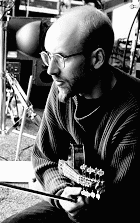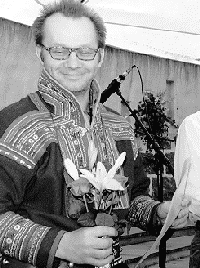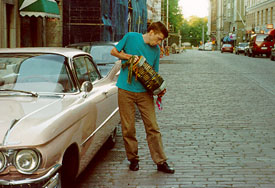VARIOUS ARTISTS
Tulikulkku
Folk Music Institute
The folk music department at The Sibelius Academy in
Helsinki is a model for both national musical pride and bold
innovation. Under the leadership oif Heikki Laitinen from 1974 to
1984, and with his continued participation as a lecturer to this
day, Sibelius includes as staff and alumni spome of Finlands most
creative musicians. In honor of his 50th birthday, his students
and comrades in music at the academy and the Finnish Folk
Music Institute have put together a birthday tribute called
Tulikulkku Here is the perfect introduction to what can
really happen when folk music is turned loose as a living,
growing force. Traditional a capella singing takes on new
formes, Lappish joiking meets electronics and guitars, and
traditional instruments are taken into the world of free-
improvisation and new world art. If you have any doubt of how
powerful a force folk music can be in the modern world, take a
listen to the live "Mikonkatu," an absolutely stunning fusion of
pre-historic sounds and contemporary force. Then get into tracks
from Hedningarna, Niekku (with Arto Järvälä and Maria Kalaniemi)
and the primitive Primo (is there a band Arto doesn't play in in
Finland?).
HEDNINGARNA
Trä
Silence / Sweden ; Northside / US
On Trä (Which I am told is a word play on "three" and "wood") this Finnish/Swedish band has acheived
yet another milestone on their quest for a new local music for
Scandinavia. Their research into the ancient legends and music of
their homes, their reconstruction of old instruments linked to
their use of modern technology has put them in the forefront of
new music. In one breath there are fiddles and lutes in an almost
barogue setting, and then suddenly ancient harps are run through
a mixmaster of electronics, voices are synthesized, bagpipes get
fuzz boxes and ouds sound like the last dream of Jimmy Hendrix.
When they play on stage they draw a crowd of young toughs and
aging hippies, a testemant to the fact that they are making music
that speaks not to modern pop culture's "generations" but to the
universal soul and wit of their own culture. Trä is a
testament to the strength of that local approach. All the
trappings of pop are there, but none of the sell-outs. This is
high energy rock music that sounds like nothing that could
be made outside of Scandinavia.

HEDNINGARNA
Kaksi!
Silence / Sweden ; Northside / US
HEDNINGARNA take the ancient music of Sweden and turns it into an
impressive folk-rock hybrid. Comparisons to Filarfolket, Mouth Music and
even Peter Gabriel come to mind, but only in terms of approach, not sound.
There are few new bands that seem to define their own genre, but this is
one of them. Synthesizers and bagpipes mingle with processed vocals and
keyed fiddles. African rhythms stir up a pot of Scandinavian dance steps,
and not a single track on the album slips by unnoticed. Kaksi! (Silence, S-
670 41, Koppom, Sweden) is an experience unto itself, looking to the past while adamantly living in the future. NEW music...
See also Hippjokk (1997)
WIMME
Rockadillo Records / Northside-US
 Our excursion is to the northern reaches of
Scandinavia, to the land known as Lapland or Samiland. Here, a
vocal form called yoiking gives the singer a personal
freedom to create an almost visual representation of the people,
places and things around her. There is a strict approach to
structures and scales, but it is the improvisation, the personal
nature of each yoik, that makes the music moving. WIMME will be
known to some folks for his appearances with Hector Zazou,
Hedningarna and the techno-jazz-joik band RinneRadio. He was not
raised a singer, but rather learned the music during a stint at
the Finnish Broadcasting Company, where he found tapes of his
uncle and decided to pick up the family tradition. On Wimme
(Rockadillo Records) he makes yoiks
without compromise, and then adds musical ambiance and rhythms
that never alter the original beauty of the singing. The
accompaniments range from the simplest drones and woodwinds to
elaborate, beautiful electro-acoustic landscapes, full of
intensity and a clarity that never gets sullied by over-
production.
Our excursion is to the northern reaches of
Scandinavia, to the land known as Lapland or Samiland. Here, a
vocal form called yoiking gives the singer a personal
freedom to create an almost visual representation of the people,
places and things around her. There is a strict approach to
structures and scales, but it is the improvisation, the personal
nature of each yoik, that makes the music moving. WIMME will be
known to some folks for his appearances with Hector Zazou,
Hedningarna and the techno-jazz-joik band RinneRadio. He was not
raised a singer, but rather learned the music during a stint at
the Finnish Broadcasting Company, where he found tapes of his
uncle and decided to pick up the family tradition. On Wimme
(Rockadillo Records) he makes yoiks
without compromise, and then adds musical ambiance and rhythms
that never alter the original beauty of the singing. The
accompaniments range from the simplest drones and woodwinds to
elaborate, beautiful electro-acoustic landscapes, full of
intensity and a clarity that never gets sullied by over-
production.
This is a special recording, not only for its unity and
direction, but because it once again shows how an intense artist
with a singular vision can create new music without delving into
cliché; use the old ways without ever falling into the
trap of either revivalism or obliteration.
ANNA-KAISA LIEDES
Kuuttaren Korut
Olarin
The Finns continue to explore and expand the music of their
roots. If you found the instrumental approach of Maria
Kalaniemi's new album on Green linnet exciting, then you should
go the effort of getting this album. Singer Liedes has gone
digging for old songs from Ostrobothnia, Karelia and Ingria, and
with the help of folks like Kalaniemi and her band, has forged a
new music that captures the old spirit and then expands it with
Finnish folk, gipsy jazz, pygmy vocal percussions and Tanzanian
pluck. Her voice is a joy, the arrangements sparse and edgy, the
music both earthy and surreal. Once again, my belief is
confirmed: only by knowing the deepest roots of her own culture
can an artist hope to make truly creative "world music."
NYPYKÄT
Elämä On Sumfaraa
Kanuunaralli
Poko Records/Finland
They call themselves "the kings of polkka" but that's like
calling the Pogues the kings of ceili. This is a ten member rock
and roll band with a bad attitude, a sense of humor, and a love
of the old music of their country that comes out as sometimes
respectful, but more often as sly parody or outright badgering.
Electric guitars, fiddles, bass, drums and of course, accordion
seem standard enough. On Elämä On Sumfaraa they
add a bit more electronic keyboard that gives some of their best
tunes, like the thumping, psuedo-reggae/polkka fusion "Anna
Armoa" a pleasant, cheesy feeling. It also makes a spit-fire
minute and a half send up of "My Sharona" come to life.
Kanuunaralli definately has the edge for energy, with a
slightly folkier feel that seems better suited to their
particular brand of humor. The arrangements are a paste-up of
changing rhythms and manaical turn-arounds. Nothing deep or
intense here, Nypykät are high-octane folk pop
fun.
NIEKKU
Niekku 3
Olarin Music
The five women who comprised Niekku were all former students
of the country's only music "high school" and are now performers
and teachers. They sing warm, gentle harmonies, play accordions,
kantele (the lap harp), mandolins, bass and fiddle. The music
they make on Niekku 3 (Olarin Music, Finland) is
deceptive, in that the tones of all the instruments and voices
are usually light and sweet, but at times the groupings of the
harps and voices gets down-right furious, and once or twice it
even gets a little skewed and bizarre. One tune weaves its way
through music box-like melodies on the kantele, with the
accordions eventually overwhelming them in discordant madness,
and then drifts slowly back to the ground. It is this splendid
use of old instruments and new ideas that typifies Niekku's
approach to their music.

 Then there is the voice of Nikolai Blad [Eino EICD-4], a master of Finno-Ugric blues. Here's a voice to rival the breaking notes of Michael Hurley or Robin Williamson, wrapped around a language as tough as the terrain, and accompanied by a guitar as funky as anything Mississippi has donated to the world. But, marvel of marvels, in the hands of producer Andrew Cronshaw, Blad becomes a real troubadour, almost a romantic. Behind him are the best of Finlands folk-avant scene, the eerie flute of Kristin Illmonen, bassist Tapani Varis (rapidly becoming as ever-present as
Then there is the voice of Nikolai Blad [Eino EICD-4], a master of Finno-Ugric blues. Here's a voice to rival the breaking notes of Michael Hurley or Robin Williamson, wrapped around a language as tough as the terrain, and accompanied by a guitar as funky as anything Mississippi has donated to the world. But, marvel of marvels, in the hands of producer Andrew Cronshaw, Blad becomes a real troubadour, almost a romantic. Behind him are the best of Finlands folk-avant scene, the eerie flute of Kristin Illmonen, bassist Tapani Varis (rapidly becoming as ever-present as 
 Our excursion is to the northern reaches of
Scandinavia, to the land known as Lapland or Samiland. Here, a
vocal form called yoiking gives the singer a personal
freedom to create an almost visual representation of the people,
places and things around her. There is a strict approach to
structures and scales, but it is the improvisation, the personal
nature of each yoik, that makes the music moving. WIMME will be
known to some folks for his appearances with Hector Zazou,
Hedningarna and the techno-jazz-joik band RinneRadio. He was not
raised a singer, but rather learned the music during a stint at
the Finnish Broadcasting Company, where he found tapes of his
uncle and decided to pick up the family tradition. On Wimme
(Rockadillo Records) he makes yoiks
without compromise, and then adds musical ambiance and rhythms
that never alter the original beauty of the singing. The
accompaniments range from the simplest drones and woodwinds to
elaborate, beautiful electro-acoustic landscapes, full of
intensity and a clarity that never gets sullied by over-
production.
Our excursion is to the northern reaches of
Scandinavia, to the land known as Lapland or Samiland. Here, a
vocal form called yoiking gives the singer a personal
freedom to create an almost visual representation of the people,
places and things around her. There is a strict approach to
structures and scales, but it is the improvisation, the personal
nature of each yoik, that makes the music moving. WIMME will be
known to some folks for his appearances with Hector Zazou,
Hedningarna and the techno-jazz-joik band RinneRadio. He was not
raised a singer, but rather learned the music during a stint at
the Finnish Broadcasting Company, where he found tapes of his
uncle and decided to pick up the family tradition. On Wimme
(Rockadillo Records) he makes yoiks
without compromise, and then adds musical ambiance and rhythms
that never alter the original beauty of the singing. The
accompaniments range from the simplest drones and woodwinds to
elaborate, beautiful electro-acoustic landscapes, full of
intensity and a clarity that never gets sullied by over-
production.